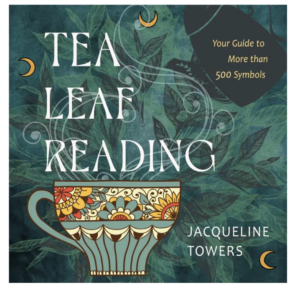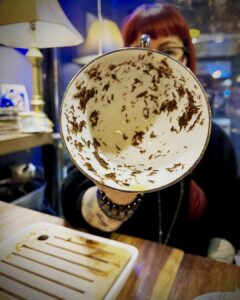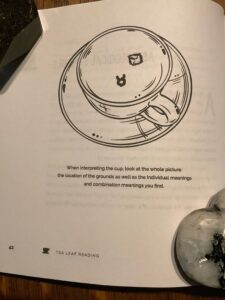We all enjoy a good cuppa tea, but why not take that enjoyment step further with doing a little tea leaf reading as an added bonus! Tea leaf reading, while it sounds like a parlour trick, is a simple form of divination that is fun and can be done by anyone! Sure, there are professionals out there who can do the readings for you, but why not invoke some of the essence of ‘French Salon’, or ‘Victorian Afternoon Tea’ of days gone by, and try this fun form of fortune telling during your next tea session with friends? This little book, Tea Leaf Reading: Your Guide to more than 500 Symbols is a perfect companion for just that. Read on for more.
I really enjoyed Jacqueline Towers’ little book on tea leaf reading. She starts off the book with a dedication to her great grandmother Dorothy Young. I love this because it reminds me of my own personal connection with the art of tea leaf reading, as it was my great grandmother who was the tea leaf reader in my family as well.
The book itself is actually broken down into eight very concise sections and it is a very easy read. You could sit down with a cup of tea and in an afternoon, learn how to do this Art on your own. I found her introduction quite interesting because she speaks of the potential origins of tea leaf reading, and while she like many others say that tea leaf reading comes from the ancient Chinese, the truth is that we really just don’t know for sure, as the Art was passed down family lines orally, and we know that the Art became most popular in the UK.
I also enjoyed how she speaks to the Art of coffee grind reading, as this is something that is still done in this day and age. I like how she speaks about its origins from Turkey, way back in the 15th, 16th and 17th centuries. Coffee reading was more popular because it was coffee that made its way around the world, prior to tea. But as tea, as it made its way around the world, it certainly began to outshine coffee as a divinatory tool.

In her introduction of the book she has a paragraph that I quite enjoyed and she says this about the differences between coffee and tea leaf reading:
“One major difference between tea leaf and coffee ground reading and these other ancient forms of divination, is that the ´questioner’ must hold the cup in their hands and she must drink from it. This means the questioner must hold the cup and its contents within the innermost part of her aura for around 10 or 15 minutes…. This creates a more personal contact than merely shuffling a deck of cards…”
She’s absolutely correct. A coffee can be drunk like a shot, think espresso, but a cup of tea is meant to be savoured, and enjoyed, and of course we all know that tea is best when it is shared. So, to me, what she implies with this quote is that it’s about an enjoyable experience, not to be an intense experience, and I really liked how she did that.
“So can anyone read the tea leaves? Yes, anyone can. Obviously those who have an artistic eye will pick up this skill more quickly than someone who is not so artistic… One tip here is not to try too hard, but to allow your eyes to go slightly out of focus for a while as you gaze into the cup. After this, sharpen your focus again, and you will find the leaves almost gathering together in your cup (or in your minds eye) create shapes and symbol.”
Through the book, she talked about developing psychic abilities as well as what psychic ability actually is. I find that she’s very conscious about how people could and could not connect to their own innate intuition, she goes lightly into psychic ability and choosing a type of divination that works for you is a very personal experience, and one that should be taken over time, and not in an instant.
Her first chapter is all about tea leaf reading and again she goes into some of the history, which I find interesting as she talks about the areas of the world where tea is grown, she also speaks about the origins of coffee as well. I like this because Tasseomancy is the art of reading both coffee and tea leaves found at the bottom of a cup.
 The author goes into the categories of different types of teas, and unfortunately she obviously hit some old research along the way where the term fermented was being used as opposed to oxidization for the leaves. Aside from that inaccuracy, she’s not too far off with what she said about tea itself. This area in my opinion, could have been better researched.
The author goes into the categories of different types of teas, and unfortunately she obviously hit some old research along the way where the term fermented was being used as opposed to oxidization for the leaves. Aside from that inaccuracy, she’s not too far off with what she said about tea itself. This area in my opinion, could have been better researched.
Then the author speaks about the origins of Tasseomancy, potentially coming from China and how it later became associated with the Romani wayfarers, or as they were once called Gypsies, which was a practice where they went from door to door offering to read the dregs of peoples morning tea or coffee for a few pence, or in a lot of cases the leftover tea leaves. The reality is, we really are unsure of the origins of the Art, but there is definitely room here for more to have been said about it.
I do enjoy how she broke down the word Tasseomancy meaning tea leaf reading and she writes here that it comes from the Arabic Word TAS meaning ´cup’, which is taken from the French word TASSE, meaning ´cup or goblet’, and the Greek suffix MANCY, which means ´prophecy’ or as I tell my students, ´form of divination’.
In chapter 2 she goes on to talk about how making a proper cup of tea, where she speaks about using all kinds of different teas that you can utilize, but she does say that examples like Darjeeling, Assam, and any kind of Chinese tea are preferable. It really is a personal thing. I love that she says to begin by “warming the tea pot, which will make the tea brew nicely”. She also speaks about the type of vessels that you will need for doing a reading; a cup and saucer, a teapot and good tea, and how to best prepare for the reading along with what to expect if it doesn’t go quite according to plan.
In the 3rd chapter she give very clear instructions on how to read a tea cup with discussing the area of the cups in significance to the location of the leaves. For example things that are close to the inquirer, and things that are away from the inquirer, the positive or the challenging parts of the cup, as well as past present and future. She gives some really nice tips for how to do readings, as well as potentially how you can do a reading for yourself.
What I also liked about this particular chapter was that what she was explaining, was that there is more than one way to read tea leaves. The traditional method that is the most common, of having the querent drink their tea almost dry, turning the cup over to drain the remnants. In the book, she gives two methods of timing (however there are more than just two) the above mentioned, as well as the blotting method for reading the leaves, which was refreshing to see in a book on Art.
In the 4th chapter onwards, she speaks about common symbols and images which can be found in tea leaf readings. But what I enjoyed about this chapter the most is the way she incorporates superstitions, which is of course old folklore and folk magic, related back to tea leaves floating in cups and whatnot.
In the following chapters, the author speaks about the different shapes that may show up by the leaves left over in a teacup, and about other symbols from other forms of divination. For example, playing cards, where we have hearts, clubs, diamonds, and spades, and what their divinatory meanings are. She also talks about Norse Runes, an ancient alphabet which has been adapted as a form of divination, that potentially could show up in a cup. The author also incorporates the idea of astrological symbols, as well as symbolism from Tarot cards which is quite refreshing to see. She discusses Numerology and the meanings of numbers, as numbers often show up in teacups.
The rest of the book has nearly 100 pages of symbols and their interpretations, which have definitions for specific shapes, a handy guide for a budding reader.
- Basket: Cheer up! You will receive a useful gift or make a new friend. At the top of the cup the sign represents a time to harvest, abundance, and material gain. Near the handle , it suggests that a new baby is on the way. If the basket is accompanied by dots, money will soon come your way. Flowers in the basket symbolized pleasurable times ahead.
- Face: It is time to face up to a situation. Is someone around you being two faced? (Look for nearby initials for clues to the identity of the person.) A face near the cups rim or its handle is a warning against too much introspection. If this sign is facing another symbol, it emphasizes the importance of that symbol. A smiling face symbolizes friendships that bring happiness and joy. An angry face means that you will soon have to deal with angry, difficult people.
- Hat: While spotting a man’s hat in a tea leaf reading is said to be an unfortunate omen, a woman’s hat is said to bring luck, honour and fame. Your efforts will be recognized and rewarded, especially in a new job. You will experience a change in roles or business success.
- Lion: This is a time for you to take control of things and to reassert yourself. Swift action will take you a long way, but at a price. Influential friends will be around. A male lion represents a powerful contact or important man, or it may represent a person born under the Zodiac sign of Leo. A lioness represents a strong family.
- Peacock: Are you being too proud or boastful- “as proud as a Peacock”? Although you may not have much luck right now, you tend to bring luck to others- and that will bring you karmic benefits later.
- Sun: The sign denotes a new beginning and enterprises that will flourish, Bringing happiness, comfort, good health, and power. A child could be of importance. A person born under the sign of Leo could be significant. Summertime is likely to become a significant period.
The final part of the book, the conclusion, I found quite pertinent, here’s a snippet:
“There aren’t really any downsides to tea leaf reading, but bear in mind that people take what they hear seriously. Even if they pretend to be blasé or to laugh it off, you can be sure that they’re taking in what you say – and they will remember it afterward… Tell him or her the truth about what you see and feel, but if you think the news is particularly bad, perhaps give up some of your “integrity” and soften the message.
This bit of advice is prudent, as from my own personal experience of over 30 years as a reader, it is very important to make sure you are keeping things real, honest, but also kind. I teach my students that learning how to use a gentle tone in your voice in response to what you are seeing in the cup, be it good, bad or ugly will leave your enquirer empowered to deal with whatever comes from the reading.
It’s also important to mention that for everyone who works with a reader of any kind, or who chooses to explore the vast realms of divination, psychics and mediums, that they, the enquirer, have free will. They can choose to use whatever information they glean from their experience, or to disregard it. It’s up to them how they disseminate the messages.
In conclusion, I feel this book is very satisfying to read with a lovely afternoon cup of tea, because after all, tea leaf reading is a simple form of divination which requires no more than a cup of tea, a quiet/reflective mood, an open mind and imagination. If I were to rate this book, I would give it a 4/5 only because of the lack of accuracy in tea information, which to me felt more like an afterthought. For anyone who would like to dabble in Tea Leaf Reading, Jacqueline Towers has written an excellent, and easy to follow guide.
Tea Market
Get More Value from Your Tea: BRU Maker One
+41794574278
Jacque's Organics
(647) 804-7263